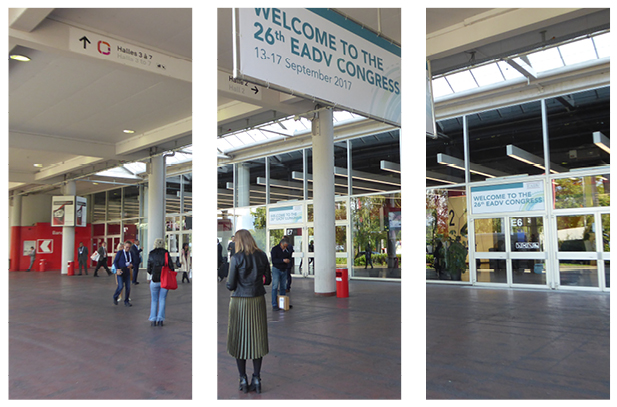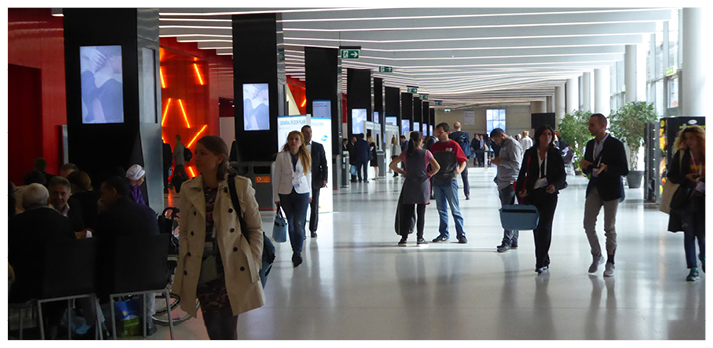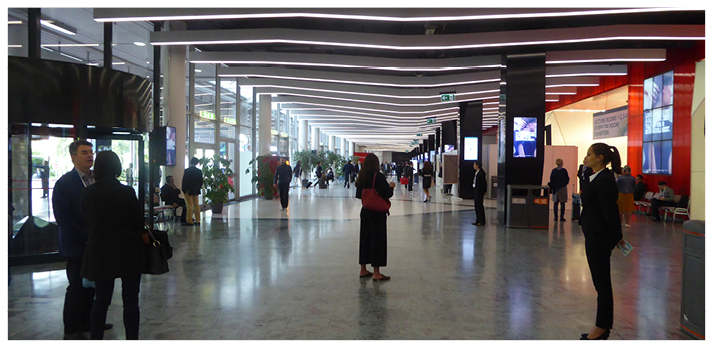A warm welcome to the European Medical Journal review of the 26th European Academy of Dermatology and Venereology (EADV) congress, held from the 13th–17th September 2017.
This year marked the EADV’s 30th anniversary, and there was no better place to celebrate the momentous event than in its home city of Geneva, Switzerland. Attracting both dermatologists and aesthetic specialists alike, the picturesque landscape of the Alps and Lake Geneva seemed most appropriate for the backdrop of this year’s congress.
Also residing in the city of Geneva, EADV President Prof Luca Borradori was pleased to welcome attendees to the spectacular Opening Plenary Lecture, in which he presented the highlights of the scientific programme, including the >150 stimulating sessions delivered by contributors from >30 countries. With a large focus over recent years on targeted immune therapies for skin disorders, the EADV scientific committee chose “Clinical immunology: The new immunotherapies” as the key theme for practising dermatologists attending this year’s congress. Dedicated to aesthetic and cosmetic dermatologists, the EADV Aesthetic Sunday programme on Sunday 17th September comprised hot topics like “Energy-based devices, including lasers” and “Botulinum toxin”.
During the opening session, Prof Borradori was also proud to introduce this year’s guest speaker, Mr Rick Guidotti, a well-known fashion and celebrity photographer. The thought-provoking presentation delivered by Mr Guidotti delved into his personal experiences of dermatology in the real-world and his most recent venture, named ‘The Spirit of Difference’, a project that uses photography to transform public perceptions of people living with genetic, physical, intellectual, and behavioural differences. Continuing the theme of breaking cultural barriers and sparking debate, a Swiss-based theatre troupe was welcomed to the stage to perform a new form of visual theatre. Insights into the human form were portrayed using shadow, light, and creative manipulation of objects, leaving the audience in awe of the stunning spectacle.
After an unforgettable beginning, the remaining 4 days consisted of continued medical education and professional development through a variety of finely-tuned sessions available to delegates. Both new and more experienced dermatologists, as well as nurses and patient organisation representatives, from around the world joined to exchange ideas and experiences, with the overall goal of improving care for patients with debilitating dermatological conditions. In his welcome speech, Prof Borradori also expressed his excitement for the opportunity to collaborate with nurses, describing their role in treating skin disease patients as: “undisputed”. He stated: “A strong and constructive relationship with both patients and nurses represents one of the strategic goals of our association.” In addition, a key theme throughout the 2017 congress was the acknowledgment of the ongoing involvement of patient advocacy groups in the field of dermatology, and EADV was keen to thank these associations for their contribution to improving patient experience. The Patient Society Village was formed where leading advocacy societies were able to showcase their role and feel the effect of their work on the larger world of European dermatology care.
The outstanding programme of the EADV 2017 congress successfully met the organisation’s goal of keeping up-to-date with the ever-changing world of skin diseases, and our following Congress Review section will summarise some of the innovative dermatological research presented in Geneva. With abstract reviews compiled by the presenters themselves, we hope you find our review insightful and educational, whether you were lucky enough to attend the congress and would like to refresh your memory, or if you are reading the data for the first time. As the year ahead promises to be exciting for dermatological practice, we look forward to hearing your ideas and experiences at next year’s EADV congress, held in Paris, France.

Combination Treatment Effectively Treats Rosacea Patients
COMBINATION treatment of rosacea has been found to be effective in treating both the inflammatory lesions and persistent erythema, according to results presented at the EADV 2017 congress. A EADV press release dated 14th September 2017 details the results of a multicentre, randomised, double-blind study assessing the efficacy, safety, and patient satisfaction of combined ivermectin 1% (IVM) cream and brimonidine 0.33% (BR) gel therapy. IVM and BR have been shown to be individually effective at treating inflammatory lesions and persistent erythema symptoms of rosacea, respectively.
Rosacea is a common inflammatory skin disease usually affecting the central areas of the face, including the cheeks, nose, and eyes; the cause of the disease is still under dispute. If left untreated, rosacea could worsen, and therefore, combined with the fact the disease affects highly visible areas of the body, there is a real need to develop an effective treatment that satisfies patients.
The study included rosacea patients with moderate-to-severe persistent erythema and inflammatory lesions. Patients were split into three cohorts, including two active cohorts; the first active group received IVM+BR for 12 weeks (BR and IVM once daily for 12 weeks), the second active group received IVM+BR for 8 weeks (initially with BR vehicle once daily for 4 weeks, followed by once daily BR for 8 weeks and with IVM for the full 12 weeks), and the control group received daily BR vehicle and IVM vehicle for 12 weeks.
A successful treatment was defined as an Investigator Global Assessment score of 0 or 1. Patients receiving either of the active treatments showed superior results for both erythema and inflammatory lesions compared to the vehicle group at 12 weeks (55.8% versus 36.8%; p=0.007). Patients in the active groups also reported similar rates for facial appearance satisfaction after the first 4 weeks of treatment compared to the vehicle group.
Lead study author, Dr Linda Stein Gold, Henry Ford Hospital, Detroit, Michigan, USA commented: “This is the first study evaluating the benefit of using both IVM 1% and BR 0.33% in combination to effectively target the multiple features of rosacea,” and went on to state: “This study develops a comprehensive and early treatment approach to this complex disease.”
Action Required to Tackle Sunbed Use
TANNING still remains popular amongst many Western populations, particularly young people, despite the health risks being widely publicised. Speaking at the EADV congress, and reported in a EADV press release dated 15th September 2017, Dr Emilie van Deventer, team leader of the radiation programme at the World Health Organization (WHO), Geneva, Switzerland, expressed her concern for the users of sunbeds, pointing out that often the technology is considered a consumer treatment and not seen as a medical device. Although improvements are being made in sunbed regulation, she suggested: “it is time to take more action.”
With ultraviolet (UV) radiation being the most significant risk factor for melanoma diagnosis, it is not surprising that 65% of melanomas are caused by UV radiation, and >10,000 melanoma cases in the USA, Europe, and Australia are attributed to sunbed use. Worryingly, >450,000 non-melanoma skin cancer cases are also caused by sunbed use. Interestingly, a French study by Grange et al.1 found a strong association between an individual having a large number of risk factors for melanoma and their use of a sunbed (p=0.001), and the WHO suggests that an age of <30 years is also a prominent risk factor, reporting: “Evidence of an association between artificially tanning and risk of skin cancer clearly shows that the risk is highest in those exposed to artificial tanning early in life”.
Understanding why people utilise sunbeds may prove useful in designing public health strategies to reduce their use. Studies have shown that some sunbed users are concerned with health, as well as beauty, however more education is required; interventions should challenge the common misconceptions about health benefits, such as the advantages of increased vitamin D levels associated with tanning. Experts also state that public health strategies that target the appearance of skin cancer are necessary to change the attitudes of sunbed users, since improved body image is a main motivator for tanning. With the high cost-burden associated with melanoma mortality and morbidity, a Belgian analysis2 highlighted the potential cost-savings of sunbed campaigns, reporting that every €1 invested in a campaign would result in a long-term saving of €3.60. Dr van Deventer explained: “This is why the WHO stresses the need for national actions to limit the use of sunbeds, in a bid to reduce the associated health risks such as melanoma and non-melanoma skin cancers and the cost to health systems.”
Dr van Deventer revealed that Brazil, after a long battle with legislation, shortly followed by Australia in 2016, was the first country to completely ban the use of sunbeds for cosmetic purposes, and many other countries have enforced rules for sunbed operators, including prohibiting unsupervised access. Moving forward, by working with a variety of global organisations, including the United Nations Environment Programme and the Global UV Project, the WHO aims to inform and advise on the health impact and effects of UV exposure, as well as guide national authorities on UV radiation protection.
During a discussion at the EADV congress, Dr van Deventer stated: “information campaigns are good, but not as productive as legislation”, highlighting the need for enforced regulation in countries where sunbed use still remains high.
References
- Grange F et al. Prevalence of sunbed use, and characteristics and knowledge of sunbed users: results from the French population-based Edifice Melanoma survey. J Eur Acad Dermatol Venereol. 2015;29(Suppl 2):23-30.
- Pil L et al. Burden of skin cancer in Belgium and cost-effectiveness of primary prevention by reducing ultraviolet exposure. Prev Med. 2016;93:177-182.

Prevention: The Best Cure for Sexually Transmitted Infections
MANAGEMENT of sexually transmitted infections (STI) is becoming more difficult for healthcare providers worldwide due to the increasing prevalence of the conditions and the stronger resistance many of these diseases are having to existing treatments. These issues, and potential solutions, were discussed in a EADV press release dated 15th September 2017.
According to data recently published by the World Health Organization (WHO), there are >1 million new cases of STI every day; for HIV, there were 153,000 new cases in the WHO European Region in 2015, the highest annual number since reporting began in the 1980s.1,2 A reason for such an increase in cases, particularly with regard to HIV, could be due to the improvement in treatments, removing the ‘fear-factor’ of acquiring the disease.
Prof Colm O’Mahony, Countess of Chester Hospital, Chester, UK, commented: “The appliance of science has resulted in HIV becoming a chronic long-term condition, no longer feared as it was in the 1980s. Some even believe, wrongly, that it can be cured. This may be one reason why people have become lax on safer sex nowadays. Back in the 1980s, fear was a major factor in changing behaviour. Prevention campaigns were based on it and had a marked effect on STI rates, but, unfortunately, that is history now.” In order to improve HIV outcomes and reduce the transmission rate, the WHO recommended that antiretroviral drug treatment be initiated for all individuals infected with HIV, regardless of their CD4 cell count. The long-term outcomes of this recommendation are still awaited.
Resistance to treatment for STI has also become an increasing problem. In HIV, pre-exposure prophylaxis is available as a preventative measure for persons at risk, including sex workers, but many are unwilling or unable to self-fund the treatment. Syphilis, a condition that has re-emerged in several high-income countries, has acquired resistance to azithromycin 2 g, and it is feared that there will be similar resistance to penicillin in the near future. Additionally, Neisseria gonorrhoea, which infects 78 million people every year, has developed resistance to every antibiotic used against it and has retained resistance against previously used antibiotics. Overall, the increasing prevalence of STI, coupled with greater resistance “will make some infections almost untreatable in years to come,” according to Prof O’Mahony.
It was in this context that Prof O’Mahony advocated his position that investment in education about sex and relationships is key to ensuring people change their behaviour and engage in safer sex to prevent STI occurring. As Prof O’Mahony pointed out: “Sure, it is difficult to argue why pre-exposure prophylaxis should be available on the NHS when there is a much cheaper solution to the problem, namely changing one’s own risk behaviour.” Designing awareness-based prevention programmes should therefore be a top priority for governments and education providers.
References
- World Health Organization. Sexually transmitted infections (STIs). Factsheet. 2016. Available at: http://www.who.int/mediacentre/factsheets/fs110/en/. Last accessed: 27 September 2017.
- World Health Organization. HIV cases reach over 2 million for the first time in Europe. 2016. Available at: http://www.euro.who.int/en/media-centre/sections/press-releases/2016/11/hiv-cases-reach-over-2-million-for-the-first-time-in-europe. Last accessed: 27 September 2017.

Can Artificial Intelligence Diagnose Skin Cancer More Accurately Than Doctors?
THE INVOLVEMENT of artificial intelligence (AI) in the diagnosis and monitoring of melanoma is very much at the forefront of development of dermatological practice, according to a press release from the EADV 2017 congress dated 15th September 2017. Medical imaging has been a prominent part of personalising cancer medicine for years, especially in the early diagnosis, treatment, and monitoring of melanoma and skin cancer. Prof Peter Soyer, The University of Queensland, Brisbane, Australia, commented: “Nowadays, new high-tech imaging, combined with AI and decision support systems, will surely redefine the early diagnosis of melanoma and skin cancer!”
A landmark study published in 20171 tested machine learning on a convolutional neural network (CNN) for the classification of skin cancer. The CNN was fed information, using only pixels and disease label inputs with data from 129,450 clinical images from 2,032 different diseases. The CNN was then tested against 21 board-certified dermatologists in identification of the most common skin cancers and then the deadliest skin cancer from biopsy-clinical images. Researchers were astonished by the results; CNN performance was equivalent to the dermatologists across both tasks. The CNN was also capable of classifying skin cancers as ‘biopsy/treatment is needed’ or ‘reassure patient/everything is fine.’
A next logical step is the progression of such AI technologies to mobile devices, allowing the reach of dermatologists outside of the clinic. Prof Soyer explained that the areas AI development is focussed on are the automated analysis of features in dermoscopy images of skin lesions, identification of potential characteristics of melanoma, and AI being integrated into software for different types of imaging platforms. Prof Soyer also expects that smartphone dermoscopic imaging with built-in AI is likely to be the most accessible method of skin lesion analysis in the future. Some smartphone apps developed for precisely this role are already available to the public; however, the sensitivity and specificity of these devices range astronomically, from 21–72% and 27–100%, respectively. Prof Soyer explained: “We have to ensure a minimum rate of false-positive and false-negative diagnoses. In the end, we are talking about melanoma, a fatal disease that people die of.”
“These devices will change the day-to-day practice of dermatologists. We will more or less exclusively see patients with cancer and suspicious lesions that have been removed. As a consequence, we will have more time for counselling on treatment, etc., because we will not have to see all the patients who have harmless skin lesions,” Prof Soyer speculated. He also cautioned that AI technology, despite its massive advantages, will have some drawbacks and stated: “…it cannot process contextual information, like family anamnesis or other symptoms. It does not see the whole patient. For these reasons, I am quite optimistic that human dermatologists will always be needed!”
References
- Esteva A et al. Dermatologist-level classification of skin cancer with deep neural networks. Nature. 2017; 542(7639):115-8.
Clear Rosacea Patients Have Delayed Time to Relapse
ROSACEA patients who achieve a clear response to treatment experience a delayed time to relapse compared to those achieving an almost clear score, according to a EADV press release dated 16th September 2017 and results presented at the EADV 2017 congress. These findings were obtained from pooled results of four studies evaluating the use of topical therapies for treating the inflammatory papules and pustules of rosacea. Results of rosacea treatment are defined on a 5-point investigator global assessment (IGA) scale; a score of 1 is defined as almost clear and a 0 score is defined as clear.
Study author Dr Guy Webster, Thomas Jefferson University, Philadelphia, Pennsylvania, USA, commented: “Rosacea is a chronic dermatological disease with remissions and exacerbations. Improving treatment options with earlier effective treatment and longer remission times may not only control symptoms, but also delay progression of the disease.” He continued to explain: “This first-of-its-kind analysis shows that both remission time and quality of life are improved if patients achieve an endpoint of clear (IGA 0), compared with patients who achieve almost clear (IGA 1).”
Patients with an IGA 0 score were associated with a delayed time to relapse of >5 months compared with IGA 1 patients. Twice as many IGA 0 patients remained treatment free at 8-month follow-up compared to the IGA 1 patients (54% versus 23%). It was commented by the researchers that this prolonged time to relapse may also contribute to improved quality of life and satisfaction with treatment for those IGA 0 patients. An additional one- third of IGA 0 patients reported a clinically meaningful difference (≥4 points) in the dermatology life quality index score than the IGA 1 patients.
Rosacea presents as flushing, permanent erythema, and inflammatory lesions and can affect both men and women equally, usually after the age of 30 years. Despite no specific cause of the disease being known, trigger factors such as spicy food, alcohol, and stress are known to affect the disease severity. Rosacea symptoms are very evident and visible, and as such the disease significantly impacts quality of life of patients in the form of anxiety, embarrassment, depression, and low self-confidence, thus warranting successful, effective treatments that enhance patient satisfaction.

A Ban on Methylisothiazolinone Finally Passed
The legal concentration of methylisothiazolinone (MI), a preservative used in cosmetics, allowed in wash-off products has been reduced in the European Union (EU), according to a EADV press release dated 15th September 2017 presented at the EADV 2017 congress.
MI, an isothiazolinone biocide, is widely used as a preservative in cosmetics to prevent micro-organism growth in products.
Surprisingly for dermatologists, this biocide is commonly used in numerous face and body products, despite its cytotoxic nature. Prior to 2000, MI was used in combination with methylchloroisothiazolinone (MCI); however, due to the observation of allergic reactions since the 1980s, there was a significant need to reassess the guidelines. The initial response to these allergic reactions was to remove MCI from products and use MI in isolation. Due to the less effective nature of MI, concentrations of MI were increased to replicate the antimicrobial nature of the MCI/MI combination.
In 2005, a cap of 100 ppm was enforced for the maximum permitted concentration of MI, which was previously unregulated. However, despite the cap on MI concentrations, severe allergic reactions were continuing to be reported. A multicentre trial of 8,680 and 7,874 patients from Belgium and France, respectively, showed a marked increase in contact allergy caused by MI. Results showed a significant sensitisation rate of ˜6.0% in 2012 and an increase to 7.0% in 2013.1 A continued increase continued to be reported in the literature.
As a result of the continued increase in allergic reports, a ban on using MCI/MI mixture in leave-on cosmetics was also introduced in July 2015, followed by a ban on the inclusion of MI in leave-on cosmetics earlier this year, in February 2017. Despite this positive step in the right direction, Prof An Goossens, Leuven, Belgium explained: “The ban on the use of MI needs to be extended, with stricter regulations on the use of this agent in rinse-off products.” In rinse-off products MCI/MI and MI alone can be present in concentrations of up to 15 ppm and 100 ppm, respectively, but dermatologists have been campaigning for a further reduction in legal concentrations.
A prospective study at 11 European dermatology departments from 8 countries collected data from the 1st May until 31st October 2015 from patients with positive MI patch tests. MI allergic patients were found to develop an allergic reaction to soap at 100 ppm (10 of 10 patients) and to 50 ppm soap (7 of 9 patients) during 21-day application; no reactions were observed for those using soap without MI. As such, dermatologists believe the limit of 100 ppm for rinse-off products is still too high.
Prof Goossens reported: “We dermatologists believe that the maximum concentration should not be higher than 15 ppm for rinse-off products.” As a result of the increased discussion surrounding the use of MI in cosmetic products, dermatologists have gained greater understanding of the effects such molecules in cosmetics can have, even at seemingly low concentrations. As a result of dermatologists’ persistence, the maximum concentration of 15 ppm has been agreed upon in the EU earlier this year and is expected to be implemented in April 2018. The passing of new EU legislation on the use of MI in rinse-off cosmetics has been a massive success for dermatologists throughout the continent and will pave the way for other molecules to be reassessed and regulations altered as required, ensuring the public safety.
References
- Aerts O et al. Contact allergy caused by methylisothiazolinone: The Belgian-French experience. Eur J Dermatol. 2015;25(3):228-33.








